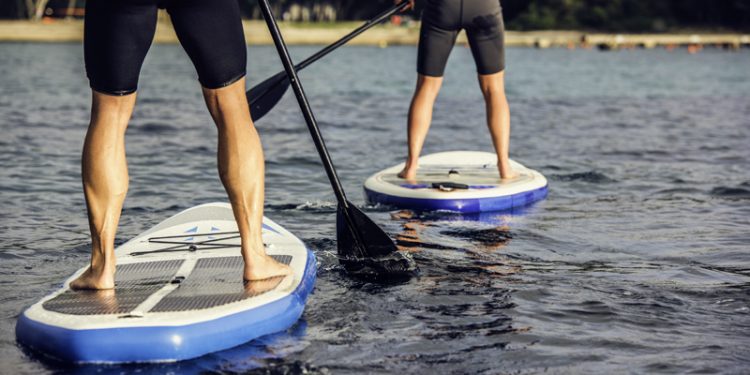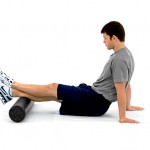If you have clients who are interested in stand-up paddleboarding (or just want better balance and strength), this is the workout to try. While it’s true that dry-land training can only get you so far when it comes to stand-up paddleboarding (SUP), the OPTTM model’s focus on Stabilization Endurance and Strength Endurance in Phase 1 and Phase 2 can give newcomers and experienced paddlers alike a leg up. “The ever-changing challenge of SUP frequently results in fatigue as the leg muscles are firing and the body is constantly working to maintain balance,” says Jerry Napp, MA, NASM-CPT, CES, PES, a stand-up paddleboarder, based in Weeki Wachee, Fla. In his view, dry-land training to improve dynamic balance and stabilization will ultimately improve performance in SUP. Plus, Napp points out, research has shown that improvement in strength improves balance—and the OPT model is a win here as well.
Adding Instability The workout here features exercises with increased instability through the use of BOSU trainers, core boards, and stability balls. That said, keep it safe, and be sure that clients use proper form. “Falling out of balance in a gym environment can be more dangerous than falling off a paddleboard into the water,” Napp says.
Building Balance For clients interested in SUP, add the following routine two or three times per week to help improve stability on the board. Work in order through each step, to progress from flexibility and movement preparation (moves 1 through 4, which can also be performed before SUP outings) to stabilization strength exercises (moves 5 through 11). Aim for one set of moves 1 through 4 (as indicated) and two sets of moves 5 through 11 (8 to 12 reps each), with a focus on form, balance, and proper breathing.
1. Foam-Roll Calf Stretch
A. Place a foam roll under the mid-calf. Cross left leg over right.
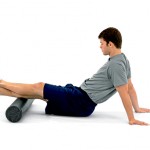 B. Slowly roll calf area to find the most tender spot. Hold pressure on tender spot until discomfort is reduced, at least 30 seconds. Switch legs and repeat.
B. Slowly roll calf area to find the most tender spot. Hold pressure on tender spot until discomfort is reduced, at least 30 seconds. Switch legs and repeat.
2. Lat Ball Stretch
A. Kneeling, place one arm on the ball, with thumb pointing up.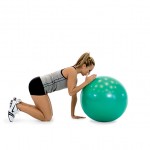
B. Draw navel toward spine and slightly round the back. Slowly reach the arm straight out by rolling the ball forward. Hold for 30 seconds, then switch sides.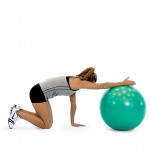
3. Kneeling Hip Flexor Stretch
A. Kneel on one leg, with the other leg bent at 90 degrees in front.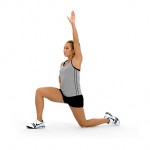 B. Contract the glutes and shift forward. Raise the arm that is on the same side as the knee touching the ground, and rotate the hip toward the opposite side until a mild stretch is felt in the front of the pelvis. Hold for 30 seconds, then switch sides.
B. Contract the glutes and shift forward. Raise the arm that is on the same side as the knee touching the ground, and rotate the hip toward the opposite side until a mild stretch is felt in the front of the pelvis. Hold for 30 seconds, then switch sides. 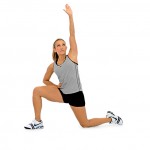 4. Prisoner Squat
4. Prisoner Squat
A. Stand straight, feet shoulder-width apart. Draw navel toward spine. Place hands behind head, pulling shoulders and elbows back.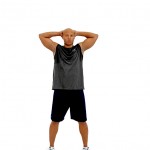 B. Slowly lower to a squat position (toes straight ahead, knees in line with toes). Extend hips, knees, and ankles back to standing. Repeat 10 times.
B. Slowly lower to a squat position (toes straight ahead, knees in line with toes). Extend hips, knees, and ankles back to standing. Repeat 10 times.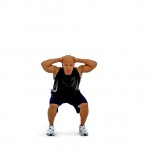 5. Stability Ball Chest Press
5. Stability Ball Chest Press
A. Holding a pair of dumbbells, lie back on the ball, keeping a bridge position with feet flat on the floor, shoulder-width apart.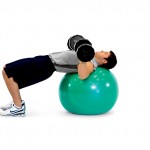 B. Press the dumbbells straight up by contracting chest and extending elbows. Hold, then slowly return to starting position. Repeat.
B. Press the dumbbells straight up by contracting chest and extending elbows. Hold, then slowly return to starting position. Repeat.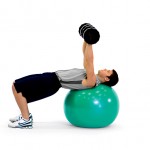 6. BOSU Shoulder Press
6. BOSU Shoulder Press
A. Holding a set of dumbbells, stand on the flat side of a BOSU trainer, feet shoulder-width apart. Raise the dumbbells to shoulder height, elbows pointing out.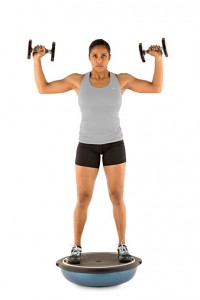 B. Press arms directly overhead. Slowly lower to the starting position. Repeat.
B. Press arms directly overhead. Slowly lower to the starting position. Repeat. 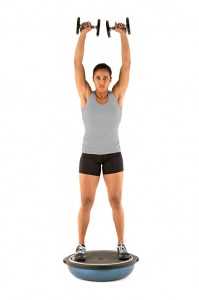 7. Standing Cable Row
7. Standing Cable Row
A. Stand facing a cable machine, feet shoulder-width apart, toes pointing ahead. Hold the cables with arms extended at chest level.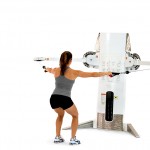 B. Slightly flex the knees, then row the cable by flexing the elbows and pulling the shoulder blades together. Slowly return to starting position. Repeat.
B. Slightly flex the knees, then row the cable by flexing the elbows and pulling the shoulder blades together. Slowly return to starting position. Repeat.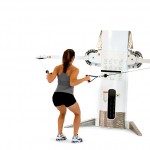 8. Ball Wall Squat
8. Ball Wall Squat
A. With a dumbbell in each hand, stand with feet shoulder-width apart and back on a stability ball placed against a wall.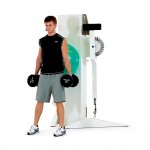 B. Slowly squat, bending knees in line with toes and flexing hips. Allow the pelvis to sit back under the ball while maintaining a neutral spine. Contract glutes to rise, placing pressure on heels as knees extend. Repeat. Progress to incorporate an unstable surface such as a core board.
B. Slowly squat, bending knees in line with toes and flexing hips. Allow the pelvis to sit back under the ball while maintaining a neutral spine. Contract glutes to rise, placing pressure on heels as knees extend. Repeat. Progress to incorporate an unstable surface such as a core board. 9. Single-Leg Pulldown
9. Single-Leg Pulldown
A. Stand on one leg, knee slightly bent, facing a cable machine. Grab the cables with arms extended overhead and palms facing down.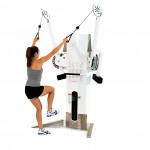 B. Pull the cables down, moving the elbows to the sides, squeezing the shoulder blades together. Hold, then slowly return to the starting position. Repeat, switching legs between sets.
B. Pull the cables down, moving the elbows to the sides, squeezing the shoulder blades together. Hold, then slowly return to the starting position. Repeat, switching legs between sets.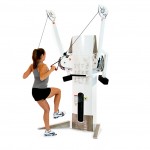 10. Cable Squat
10. Cable Squat
A .Face a cable machine, with feet shoulder-width apart, toes pointed straight ahead. Hold cables at the sides of the body.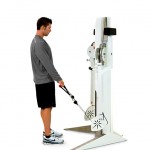 B. Slowly squat, bending knees and keeping chest up and feet straight. Contract glutes and press through the heels while returning to the starting position. Repeat. Progress to perform while standing on a core board or the flat side of a BOSU trainer.
B. Slowly squat, bending knees and keeping chest up and feet straight. Contract glutes and press through the heels while returning to the starting position. Repeat. Progress to perform while standing on a core board or the flat side of a BOSU trainer.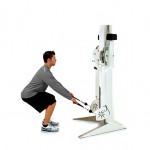 11. Single-Leg Squat to Row
11. Single-Leg Squat to Row
A .Face a cable machine with a grip in each hand, arms extended toward the floor, palms inward. Raise one leg off the floor.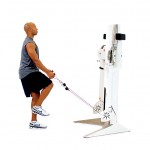 B. Keep arms extended with back straight and squat until thighs are at least parallel to the floor, keeping knees from going in front of toes.
B. Keep arms extended with back straight and squat until thighs are at least parallel to the floor, keeping knees from going in front of toes.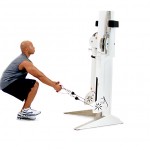 C. Stand with leg off the floor, pulling the handles to the bottom of the rib cage, with elbows in and shoulder blades squeezing together. Keep the leg raised while extending arms. Repeat, switching legs between sets.
C. Stand with leg off the floor, pulling the handles to the bottom of the rib cage, with elbows in and shoulder blades squeezing together. Keep the leg raised while extending arms. Repeat, switching legs between sets.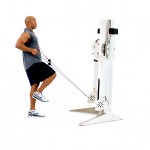 Bonus Moves Balance is key to SUP—but so is being able to quickly move to a standing position. Heather Wildman, NASM-CPT, suggests Mountain Climbers and Surfer Pop-Ups to help SUPers get up fast and keep moving forward.
Bonus Moves Balance is key to SUP—but so is being able to quickly move to a standing position. Heather Wildman, NASM-CPT, suggests Mountain Climbers and Surfer Pop-Ups to help SUPers get up fast and keep moving forward.

